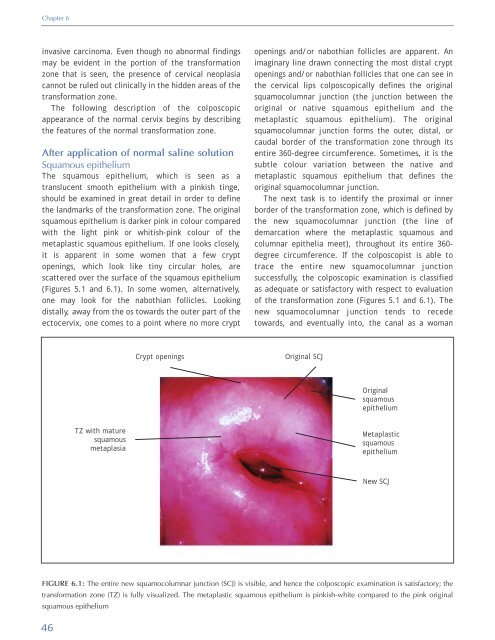Colposcopy and Treatment of Cervical Intraepithelial Neoplasia - RHO
Colposcopy and Treatment of Cervical Intraepithelial Neoplasia - RHO
Colposcopy and Treatment of Cervical Intraepithelial Neoplasia - RHO
You also want an ePaper? Increase the reach of your titles
YUMPU automatically turns print PDFs into web optimized ePapers that Google loves.
Chapter 6<br />
invasive carcinoma. Even though no abnormal findings<br />
may be evident in the portion <strong>of</strong> the transformation<br />
zone that is seen, the presence <strong>of</strong> cervical neoplasia<br />
cannot be ruled out clinically in the hidden areas <strong>of</strong> the<br />
transformation zone.<br />
The following description <strong>of</strong> the colposcopic<br />
appearance <strong>of</strong> the normal cervix begins by describing<br />
the features <strong>of</strong> the normal transformation zone.<br />
After application <strong>of</strong> normal saline solution<br />
Squamous epithelium<br />
The squamous epithelium, which is seen as a<br />
translucent smooth epithelium with a pinkish tinge,<br />
should be examined in great detail in order to define<br />
the l<strong>and</strong>marks <strong>of</strong> the transformation zone. The original<br />
squamous epithelium is darker pink in colour compared<br />
with the light pink or whitish-pink colour <strong>of</strong> the<br />
metaplastic squamous epithelium. If one looks closely,<br />
it is apparent in some women that a few crypt<br />
openings, which look like tiny circular holes, are<br />
scattered over the surface <strong>of</strong> the squamous epithelium<br />
(Figures 5.1 <strong>and</strong> 6.1). In some women, alternatively,<br />
one may look for the nabothian follicles. Looking<br />
distally, away from the os towards the outer part <strong>of</strong> the<br />
ectocervix, one comes to a point where no more crypt<br />
openings <strong>and</strong>/or nabothian follicles are apparent. An<br />
imaginary line drawn connecting the most distal crypt<br />
openings <strong>and</strong>/or nabothian follicles that one can see in<br />
the cervical lips colposcopically defines the original<br />
squamocolumnar junction (the junction between the<br />
original or native squamous epithelium <strong>and</strong> the<br />
metaplastic squamous epithelium). The original<br />
squamocolumnar junction forms the outer, distal, or<br />
caudal border <strong>of</strong> the transformation zone through its<br />
entire 360-degree circumference. Sometimes, it is the<br />
subtle colour variation between the native <strong>and</strong><br />
metaplastic squamous epithelium that defines the<br />
original squamocolumnar junction.<br />
The next task is to identify the proximal or inner<br />
border <strong>of</strong> the transformation zone, which is defined by<br />
the new squamocolumnar junction (the line <strong>of</strong><br />
demarcation where the metaplastic squamous <strong>and</strong><br />
columnar epithelia meet), throughout its entire 360-<br />
degree circumference. If the colposcopist is able to<br />
trace the entire new squamocolumnar junction<br />
successfully, the colposcopic examination is classified<br />
as adequate or satisfactory with respect to evaluation<br />
<strong>of</strong> the transformation zone (Figures 5.1 <strong>and</strong> 6.1). The<br />
new squamocolumnar junction tends to recede<br />
towards, <strong>and</strong> eventually into, the canal as a woman<br />
Crypt openings<br />
Original SCJ<br />
Original<br />
squamous<br />
epithelium<br />
TZ with mature<br />
squamous<br />
metaplasia<br />
Metaplastic<br />
squamous<br />
epithelium<br />
New SCJ<br />
FIGURE 6.1: The entire new squamocolumnar junction (SCJ) is visible, <strong>and</strong> hence the colposcopic examination is satisfactory; the<br />
transformation zone (TZ) is fully visualized. The metaplastic squamous epithelium is pinkish-white compared to the pink original<br />
squamous epithelium<br />
46
















